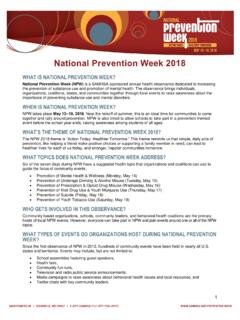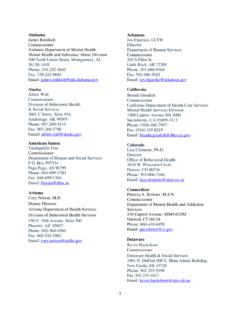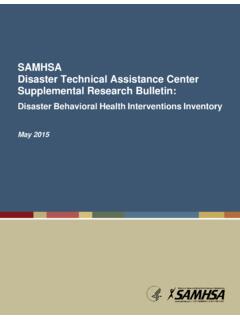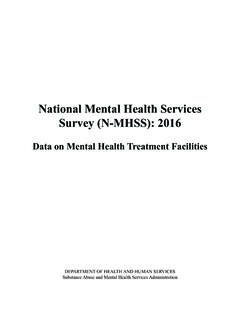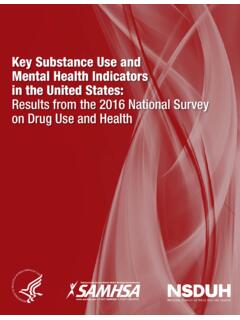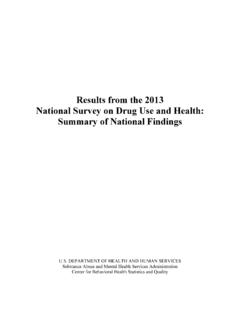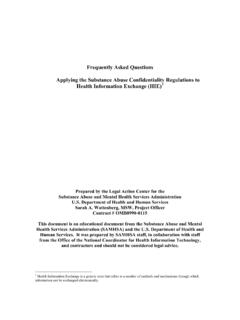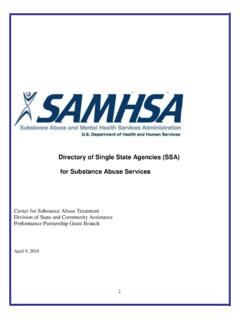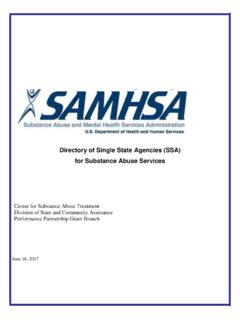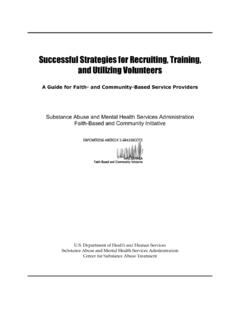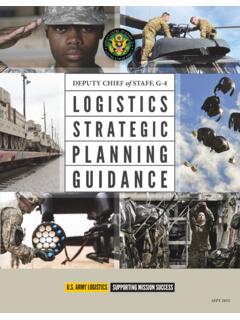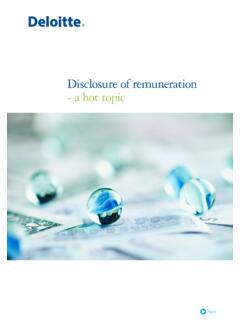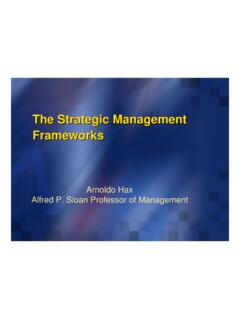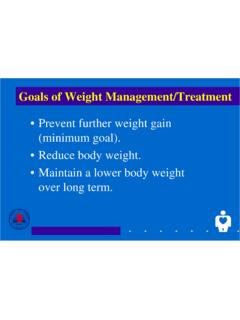Transcription of A Guide to SAMHSA’s Strategic Prevention Framework
1 JUNE 2019A Guide to SAMHSA sStrategic PreventionFrameworkAcknowledgmentsThe content of this report was developed by SAMHSA staff. The final report was formated for the Substance Abuse and Mental Health Services Administration (SAMHSA) under contract number HHSS283176901 with SAMHSA, Department of Health and Human Services (HHS). Claudia Richards served as contracting officer views, opinions, and content of this publication are those of the authors and do not necessarily reflect the views, opinions, or policies of SAMHSA or HHS. Nothing in this document constitutes a direct or indirect endorsement by SAMHSA or HHS of any non-Federal entity s products, services, or policies, and any reference to non-Federal entity s products, services, or policies should not be construed as Domain NoticeAll material appearing in this publication is in the public domain and may be reproduced or copied without permission from SAMHSA.
2 Citation of the source is appreciated. However, this publication may not be reproduced or distributed for a fee without the specific, written authorization of the Office of Communications, SAMHSA, AccessThis publication may be downloaded from CitationSubstance Abuse and Mental Health Services Administration: A Guide to SAMHSA's Strategic Prevention Framework . Rockville, MD: Center for Substance Abuse Prevention . Substance Abuse and Mental Health Services Administration, OfficeCenter for Substance Abuse Prevention , Substance Abuse and Mental Health Services Administration, 5600 Fishers Lane, Rockville, MD 20857, HHS Publication Nondiscrimination NoticeSAMHSA complies with applicable Federal civil rights laws and does not discriminate on the basis of race, color, national origin, age, disability, or cumple con las leyes federales de derechos civiles aplicables y no discrimina por motivos de raza, color, nacionalidad.
3 4 Step 1: Assessment ..6 Step 2: Capacity ..11 Step 3: Planning ..14 Step 4: Implementation ..20 Step 5: Evaluation ..23 SPF Guiding Principle: Cultural Competence .. 26 SPF Guiding Principle: Sustainability ..29 APPENDICES ..32 Appendix A: Primary Data Collection Methods ..33 Appendix B: Key Features of Risk and Protective Factors ..36 Appendix C: Levels of Involvement ..38 Appendix D: The Socio-Ecological Model ..39 Appendix E: Making the Most of Your Evaluation Dollars ..41 Appendix F: Evaluation Design, Reporting, and Lessons Learned ..43 TABLE OF CONTENTSA Guide TO SAMHSA S Strategic Prevention FRAMEWORK4 Prevention planners are pressed to put in place solutions to urgent substance misuse problems facing their communities.
4 But research and experience have shown that Prevention must begin with an understanding of these complex behavioral health problems within their complex environmental contexts; only then can communities establish and implement effective plans to address substance misuse . To facilitate this understanding, SAMHSA developed the Strategic Prevention Framework (SPF) . The five steps and two guiding principles of the SPF offer Prevention planners a comprehensive approach to understanding and addressing the substance misuse and related behavioral health problems facing their states and communities.
5 The SPF includes these five steps:1 . Assessment: Identify local Prevention needs based on data (e .g ., What is the problem?)2 . Capacity: Build local resources and readiness to address Prevention needs (e .g ., What do you have to work with?)3 . Planning: Find out what works to address Prevention needs and how to do it well (e .g ., What should you do and how should you do it?)4 . Implementation: Deliver evidence-based programs and practices as intended (e .g ., How can you put your plan into action?)5 . Evaluation: Examine the process and outcomes of programs and practices (e.)
6 G ., Is your plan succeeding?)The SPF is also guided by two cross-cutting principles that should be integrated into each of the steps that comprise it: Cultural competence. The ability of an individual or organization to understand andinteract effectively with people who have different values, lifestyles, and traditions based on their distinctive heritage and social relationships . Sustainability. The process of building an adaptive and effective system that achieves andmaintains desired long-term results .INTRODUCTION5 The SPF has several defining characteristics that set it apart from other Strategic planning processes.
7 Most notably, it is: Dynamic and iterative. Assessment is the starting point, but planners will return to thisstep again and again as their community s substance misuse problems and capacities evolve . Communities may also engage in activities related to multiple steps simultaneously . For example, planners may need to find and mobilize additional capacity to support implementation once a program or practice is underway . For these reasons, the SPF is a circular rather than a linear model . Data-driven. The SPF is designed to help planners gather and use data to Guide all preventiondecisions from identifying which substance misuse problems to address in their communities, to choosing the most appropriate ways to address these problems, to determining whether communities are making progress.
8 Reliant on and encourages a team approach. Each step of the SPF requires andgreatly benefits from the participation of diverse community partners . The individuals and institutions involved in Prevention efforts may change as the initiative evolves, but the need for Prevention partners will remain constant .This toolkit provides an introduction to the SPF s well-tested and user-friendly planning approach . Organized by each of the steps in the Framework , the toolkit provides a snapshot of how each of the components fit together and build on one another . Used in tandem with its companion resource, Selecting Best-Fit Programs and Practices: Guidance for Substance Misuse Prevention Practitioners, the toolkit provides an important starting point for engaging in a thoughtful, data-driven process that supports best practices, engages critical stakeholders, and draws on evidence.
9 Adherence to the principles in the Framework increases the likelihood that Prevention efforts will produce anticipated outcomes, reduce harmful behaviors, and keep communities healthy and safe . A Guide TO SAMHSA S Strategic Prevention FRAMEWORK6 STEP 1: ASSESSMENTOVERVIEWThe purpose of this step is to understand local Prevention needs based on a careful review of data gathered from a variety of sources . These data help planners to identify and prioritize the substance misuse problems present in their community; clarify the impact these problems have on community members; identify the specific factors that contribute to these problems; assess readiness; and determine the resources required to address those factors.
10 Ultimately, a thorough and inclusive assessment process helps to ensure that substance misuse Prevention efforts are appropriate and on target . To conduct a comprehensive assessment of Prevention needs, Prevention professionals gather data about each of the following: The nature of the substance misuse problem in the community and related harmful behaviors Risk and protective factors that influence substance misuse problems, particularly those of highpriority in the community Community capacity for Prevention , including readiness and available resourcesStep 1:AssessmentStep 2:CapacityStep 3:PlanningStep 4:ImplementationStep 5:EvaluationAssessproblems and relatedbehaviorsPrioritize problems(criteria.)
